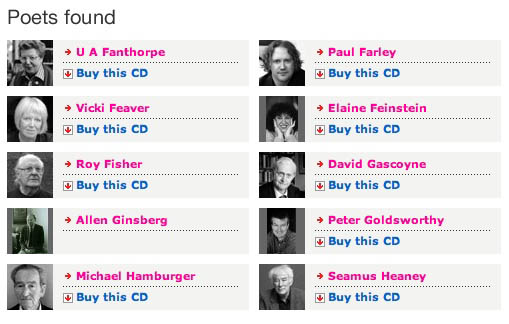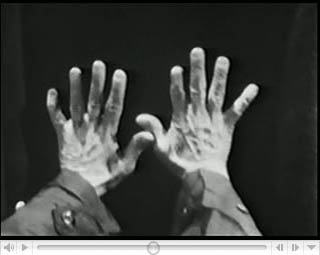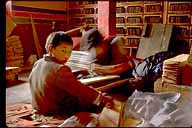
One of the odd things that strikes me about so much writing about technology is the seeming assumption that technology (and the ideas associated with it) arise from some sort of cultural vacuum. It’s an odd myopia, if not an intellectual arrogance, and it results in a widespream failure to notice many connections that should be obvious. One such connection is that between the work of many of the conceptual artists of the 1960s and continuing attempts to sort out what it means to read when books don’t need to be limited to text & illustrations. (This, of course, is a primary concern of the Institute.)
Lately I’ve been delving through the work of Dick Higgins (1938–1998), a self-described “polyartist” who might be most easily situated by declaring him to be a student of John Cage and part of the Fluxus group of artists. This doesn’t quite do him justice: Higgins’s work bounced back and forth between genres of the avant-garde, from music composition (in the rather frightening photo above, he’s performing his Danger Music No. 17, which instructs the performer to scream as loudly as possible for as long as possible) to visual poetry to street theatre. He supported himself by working as a printer: the first of several publishing ventures was the Something Else Press, which he ran from 1963 to 1974, publishing a variety of works by artists and poets as well as critical writing.
 “Betweenness” might be taken as the defining quality of his work, and this betweenness is what interests me. Higgins recognized this – he was perhaps as strong a critic as an artist – and in 1964, he coined the term “intermedia” to describe what he & his fellow Fluxus artists were doing: going between media, taking aspects from established forms to create new ones. An example of this might be visual, or concrete poetry, of which that of Jackson Mac Low or Ian Hamilton Finlay – both of whom Higgins published – might be taken as representative. Visual poetry exists as an intermediate form between poetry and graphic design, taking on aspects of both. This is elaborated (in an apposite form) in his poster on poetry & its intermedia; click on the thumbnail to the right to see a (much) larger version with legible type.
“Betweenness” might be taken as the defining quality of his work, and this betweenness is what interests me. Higgins recognized this – he was perhaps as strong a critic as an artist – and in 1964, he coined the term “intermedia” to describe what he & his fellow Fluxus artists were doing: going between media, taking aspects from established forms to create new ones. An example of this might be visual, or concrete poetry, of which that of Jackson Mac Low or Ian Hamilton Finlay – both of whom Higgins published – might be taken as representative. Visual poetry exists as an intermediate form between poetry and graphic design, taking on aspects of both. This is elaborated (in an apposite form) in his poster on poetry & its intermedia; click on the thumbnail to the right to see a (much) larger version with legible type.
Higgins certainly did not imagine he was the first to use the idea of intermedia; he traced the word itself back to Samuel Taylor Coleridge, who had used it in the same sense in 1812. The concept has similarities to Richard Wagner’s idea of opera as Gesamkunstwerk, the “total artwork”, combining theatre and music. But Higgins suggested that the roots of the idea could be found in the sixteenth century, in Giordano Bruno’s On the Composition of Signs and Images, which he translated into English and annotated. And though it might be an old idea, a quote from a text about intermedia that he wrote in 1965 (available online at the always reliable Ubuweb) suggests parallels between the avant-garde world Higgins was working in forty years ago and our concern at the Institute, the way the book seems to be changing in the electronic world:
Much of the best work being produced today seems to fall between media. This is no accident. The concept of the separation between media arose in the Renaissance. The idea that a painting is made of paint on canvas or that a sculpture should not be painted seems characteristic of the kind of social thought–categorizing and dividing society into nobility with its various subdivisions, untitled gentry, artisans, serfs and landless workers–which we call the feudal conception of the Great Chain of Being. This essentially mechanistic approach continued to be relevant throughout the first two industrial revolutions, just concluded, and into the present era of automation, which constitutes, in fact, a third industrial revolution.
Higgins isn’t explicitly mentioning the print revolution started by Gutenberg or the corresponding changes in how reading is increasingly moving from the page to the screen, but that doesn’t seem like an enormous leap to make. A chart he made in 1995 diagrams the interactions between various sorts of intermedia:

Note the question marks – Higgins knew there was terrain yet to be mapped out, and an interview suggests that he imagined that the genre-mixing facilitated by the computer might be able to fill in those spaces.
“Multimedia” is something that comes up all the time when we’re talking about what computers do to reading. The concept is simple: you take a book & you add pictures and sound clips and movies. To me it’s always suggested an assemblage of different kinds of media with a rubber band – the computer program or the webpage – around them, an assemblage that usually doesn’t work as a whole because the elements comprising it are too disparate. Higgins’s intermedia is a more appealing idea: something that falls in between forms is more likely to bear scrutiny as a unified object than a collection of objects. The simple equation text + pictures (the simplest and most common way we think about multimedia) is less interesting to me than a unified whole that falls between text and pictures. When you have text + pictures, it’s all too easy to criticize the text and pictures separately: this picture compared to all other possible pictures invariably suffered, just as this text compared to all other possible texts must suffer. Put in other terms, it’s a design failure.
A note added to the essay quoted above in 1981 more explicitly presents the ways in which intermedia can be a useful tool for approaching new work:
It is today, as it was in 1965, a useful way to approach some new work; one asks oneself, “what that I know does this new work lie between?” But it is more useful at the outset of a critical process than at the later stages of it. Perhaps I did not see that at the time, but it is clear to me now. Perhaps, in all the excitement of what was, for me, a discovery, I overvalued it. I do not wish to compensate with a second error of judgment and to undervalue it now. But it would seem that to proceed further in the understanding of any given work, one must look elsewhere–to all the aspects of a work and not just to its formal origins, and at the horizons which the work implies, to find an appropriate hermeneutic process for seeing the whole of the work in my own relation to it.
The last sentence bears no small relevance to new media criticism: while a video game might be kind of like a film or kind of like a book, it’s not simply the sum of its parts. This might be seen as the difference between thinking about terms of multimedia and in terms of intermedia. We might use it as a guideline for thinking about the book to come, which isn’t a simple replacement for the printed book, but a new form entirely. While we can think about the future book as incorporating existing pieces – text, film, pictures, sound – we will only really be able to appreciate these objects when we find a way to look at them as a whole.
An addendum: “Intermedia” got picked up as the name of a hypertext project out of Brown started in 1985 that Ted Nelson, among others, was involved with. It’s hard to tell whether it was thus named because of familiarity with Higgins’s work, but I suspect not: these two threads, the technologic and the artistic, seem to be running in parallel. But this isn’t necessarily, as is commonly suuposed, because the artists weren’t interested in technical possibilities. Higgins’s Book of Love & Death & War, published in 1972, might merit a chapter in the history of books & computers: a book-length aleatory poem, he notes in his preface that one of its cantos was composed with the help of a FORTRAN IV program that he wrote to randomize its lines. (Canto One of the poem is online at Ubuweb; this is not, however, the computer-generated part of the work.)
And another addendum: something else to take from Higgins might be his resistance to commodification. Because his work fell between the crevices of recognized forms, it couldn’t easily be marketed: how would you go about selling his metadramas, for example? It does, however, appear perfectly suited for the web & perhaps this resistance to commodification is apropos right now, in the midst of furious debates about whether information wants to be free or not. “The word,” notes Higgins in one of his Aphorisms for a Rainy Day in the poster above, “is not dead, it is merely changing its skin.”
 I was startled but not surprised to read about John Updike’s denigration of the future of ebooks at BookExpo. Had he tattooed it on his forehead he couldn’t have made clearer his idealization of 19th-century structures and modes of thinking. His talk represented the final glorification of the author/artist/creator as a higher being ingrained with heroic capabilities unapproachable by mere mortals. For Updike and all those unable to cross into the new Canaan of electronicity, the apotheosis of the artist fits into the tradition of history as a history of heroes. There are but a few gods of literature as is only natural, I expected him to say, and if you have art made by whole masses of people, many of them unidentifiable, we’ll have regressed to the period of Notre Dame cathedral or the Pyramids, in which no individuals were glorified for their contributions to art or to the era when writing went unsigned or when the writer assumed the mantle of some greater person, to glorify them and spread their thinking.*
I was startled but not surprised to read about John Updike’s denigration of the future of ebooks at BookExpo. Had he tattooed it on his forehead he couldn’t have made clearer his idealization of 19th-century structures and modes of thinking. His talk represented the final glorification of the author/artist/creator as a higher being ingrained with heroic capabilities unapproachable by mere mortals. For Updike and all those unable to cross into the new Canaan of electronicity, the apotheosis of the artist fits into the tradition of history as a history of heroes. There are but a few gods of literature as is only natural, I expected him to say, and if you have art made by whole masses of people, many of them unidentifiable, we’ll have regressed to the period of Notre Dame cathedral or the Pyramids, in which no individuals were glorified for their contributions to art or to the era when writing went unsigned or when the writer assumed the mantle of some greater person, to glorify them and spread their thinking.*

 Just the other night I saw a fantastic
Just the other night I saw a fantastic  The archive naturally focuses on British poets, but offers a significant selection of english-language writers from the U.S. and the British Commonwealth countries. Seamus Heaney is serving as president of the archive.
The archive naturally focuses on British poets, but offers a significant selection of english-language writers from the U.S. and the British Commonwealth countries. Seamus Heaney is serving as president of the archive.




